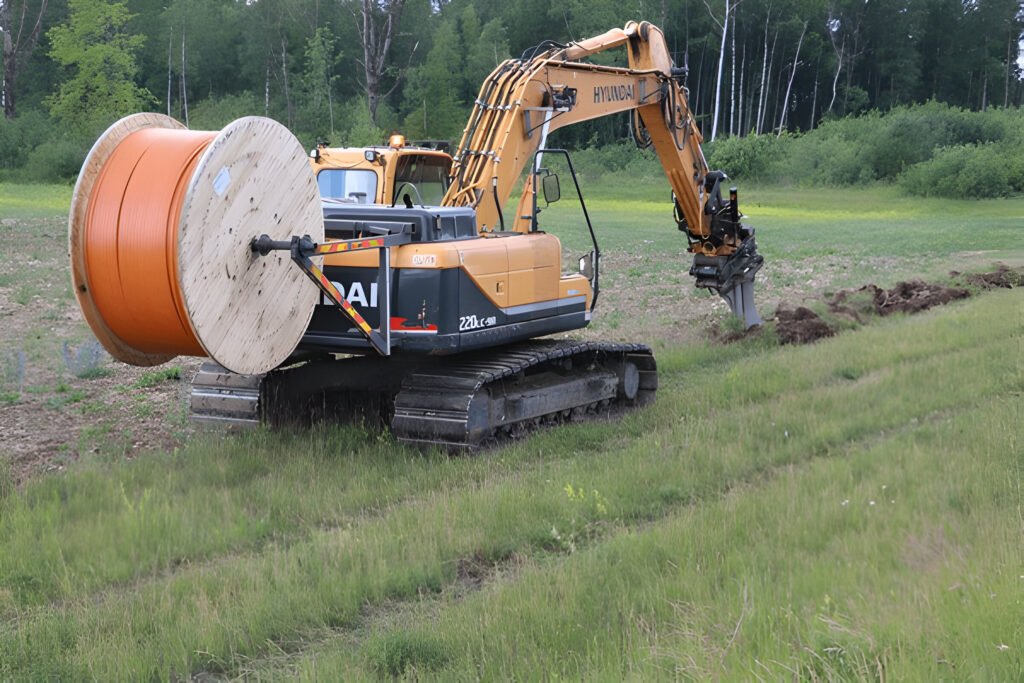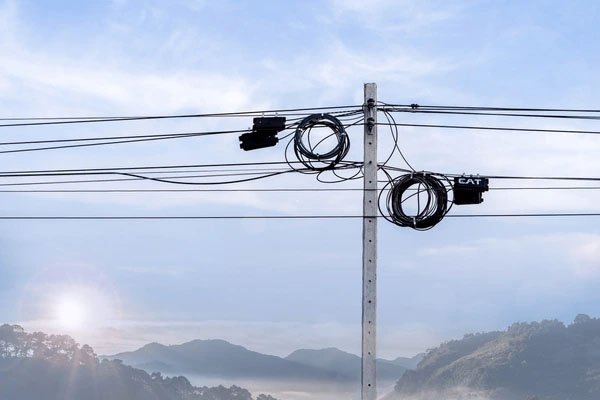Have you ever wondered how high-speed internet reaches remote areas or how cities stay connected across vast distances? The answer often lies in the type of fiber optic cables used—specifically, a direct burial fiber optic cable or an aerial fiber optic cable. These two types of fiber optic cables are designed for different environments and installation methods, each with its own strengths and challenges. In this beginner-friendly guide, we’ll explore the key considerations for choosing between a direct burial fiber optic cable and an aerial fiber optic cable, diving into their designs, applications, and factors like cost and durability. We’ll keep it simple and engaging, so you can make an informed decision for your connectivity needs. With solutions from CommMesh, let’s dive into the world of fiber optic technology and find the right fiber optic cable for your project!
What Is a Direct Burial Fiber Optic Cable?

Design and Structure of Direct Burial Fiber Optic Cable
A direct burial fiber optic cable is engineered to be buried underground without the need for additional conduit. Its design typically includes a robust outer jacket, often made of polyethylene (PE), to resist moisture and soil pressure. Inside, the cable features loose tube construction with water-blocking gel or tape to protect the optical fibers, along with strength members like aramid yarn for added durability. This sturdy build in fiber optic technology ensures a direct burial fiber optic cable can withstand the challenges of underground installation.
Key Features of Direct Burial Fiber Optic Cable
The direct burial fiber optic cable is built for underground environments, offering resistance to moisture, soil abrasion, and rodent damage. Its protective layers ensure the optical fibers remain safe from physical stress, making direct burial fiber optic cables a reliable choice for long-term underground deployments in fiber optic technology. The design focuses on durability to maintain signal integrity in harsh conditions.
Applications of Direct Burial Fiber Optic Cable
Direct burial fiber optic cables are commonly used in scenarios where cables need to be buried underground, such as rural broadband networks, campus connectivity, and long-haul telecom lines. They’re ideal for areas where above-ground installation isn’t feasible, ensuring fiber optic technology delivers consistent performance in underground settings like utility easements or cross-country routes.
What Is an Aerial Fiber Optic Cable?

Design and Structure of Aerial Fiber Optic Cable
An aerial fiber optic cable is designed to be suspended above ground, typically between utility poles or buildings. Its structure often includes a loose tube design with optical fibers protected by water-blocking materials, surrounded by strength members like aramid yarn or steel to handle tension. The outer jacket, often UV-resistant polyethylene, protects against weather exposure. This design in fiber optic technology makes an aerial fiber optic cable suitable for above-ground installations.
Key Features of Aerial Fiber Optic Cable
The aerial fiber optic cable is built to endure environmental factors like wind, ice, and UV exposure. Its strength members provide tensile strength to withstand the tension of suspension, while the outer jacket ensures longevity in outdoor conditions. This makes aerial fiber optic cables a practical choice for fiber optic technology in areas where overhead installation is preferred.
Applications of Aerial Fiber Optic Cable
Aerial fiber optic cables are widely used in urban and suburban settings, where they can be strung between poles or buildings for telecom networks, cable TV, and internet services. They’re also common in areas with existing pole infrastructure, making aerial fiber optic cables an efficient option for fiber optic technology in regions where underground burial isn’t practical.
Environmental Considerations: Direct Burial Fiber Optic Cable vs Aerial Fiber Optic Cable
Moisture and Soil Resistance for Direct Burial Fiber Optic Cable
In a direct burial fiber optic cable vs aerial fiber optic cable comparison, the direct burial fiber optic cable excels in underground environments. It’s designed to resist moisture infiltration and soil abrasion, with features like water-blocking gel ensuring the fibers stay dry. This makes direct burial fiber optic cables ideal for fiber optic technology in areas with high groundwater or heavy soil pressure.
Weather and UV Resistance for Aerial Fiber Optic Cable
An aerial fiber optic cable is built to handle above-ground challenges, such as exposure to UV light, wind, and temperature fluctuations. Its UV-resistant outer jacket protects against sun damage, while the cable’s design ensures it can endure weather-related stress. In direct burial fiber optic cable vs aerial fiber optic cable, this makes aerial fiber optic cables better suited for fiber optic technology in exposed outdoor settings.
Temperature and Physical Stress
Temperature impacts both types of fiber optic cables. A direct burial fiber optic cable must withstand soil temperature changes and pressure, which its robust design handles well. An aerial fiber optic cable faces temperature swings and physical stress from wind or ice loads, requiring strong tensile strength. This distinction in direct burial fiber optic cable vs aerial fiber optic cable highlights their suitability for specific environmental conditions in fiber optic technology.

Installation Considerations: Direct Burial Fiber Optic Cable vs Aerial Fiber Optic Cable
Trenching and Burial for Direct Burial Fiber Optic Cable
Installing a direct burial fiber optic cable involves trenching and burying the cable underground, which can be labor-intensive. The process requires digging a trench, laying the cable, and backfilling, ensuring the direct burial fiber optic cable is protected from surface activity. This method in fiber optic technology is time-consuming but offers long-term protection for direct burial fiber optic cables in underground deployments—CommMesh provides reliable solutions for such installations.
Pole and Suspension for Aerial Fiber Optic Cable
An aerial fiber optic cable is installed by suspending it between poles or structures, often using existing infrastructure. This method is generally faster than trenching, as it avoids digging and focuses on securing the aerial fiber optic cable with clamps or messenger wires. In direct burial fiber optic cable vs aerial fiber optic cable, the installation of aerial fiber optic cables is more efficient for fiber optic technology in areas with pole access.
Accessibility for Maintenance
Maintenance accessibility differs in direct burial fiber optic cable vs aerial fiber optic cable. A direct burial fiber optic cable is harder to access, requiring excavation to reach the cable, which can increase downtime during repairs. An aerial fiber optic cable is easier to access from poles, simplifying maintenance tasks in fiber optic technology, though it may be more exposed to external damage.
Durability and Longevity: Direct Burial Fiber Optic Cable vs Aerial Fiber Optic Cable
Protection Against Physical Damage for Direct Burial Fiber Optic Cable
The direct burial fiber optic cable offers superior protection against physical damage, as it’s buried underground, away from surface hazards like vehicles or vandalism. Its armored layers and robust jacket ensure direct burial fiber optic cables remain safe from rodents and soil pressure, making them a durable choice in fiber optic technology for long-term underground use.
Exposure to Elements for Aerial Fiber Optic Cable
An aerial fiber optic cable is more exposed to environmental elements, such as storms, ice, and bird activity, which can impact its longevity. While designed with UV-resistant and weatherproof materials, aerial fiber optic cables may require more frequent inspections in fiber optic technology to ensure they withstand ongoing exposure to outdoor conditions.
Lifespan and Replacement Needs
In direct burial fiber optic cable vs aerial fiber optic cable, the direct burial fiber optic cable generally has a longer lifespan due to its protected underground placement, often lasting decades with minimal maintenance. An aerial fiber optic cable may need replacement sooner due to weather-related wear, though advancements in fiber optic technology are improving the durability of aerial fiber optic cables.

Cost Considerations: Direct Burial Fiber Optic Cable vs Aerial Fiber Optic Cable
Installation Costs for Direct Burial Fiber Optic Cable
Installing a direct burial fiber optic cable can be more expensive due to the labor and equipment needed for trenching and burial. The process involves excavation, which increases costs, especially in rocky or urban areas. In direct burial fiber optic cable vs aerial fiber optic cable, this makes direct burial fiber optic cables a higher upfront investment in fiber optic technology, though it may save on long-term maintenance.
Installation Costs for Aerial Fiber Optic Cable
An aerial fiber optic cable typically has lower installation costs, as it uses existing pole infrastructure and avoids the need for trenching. The installation process is faster and less labor-intensive, making aerial fiber optic cables a more cost-effective option in fiber optic technology for areas with accessible poles or structures, though pole leasing fees may apply.
Long-Term Maintenance Costs
Maintenance costs in direct burial fiber optic cable vs aerial fiber optic cable vary. A direct burial fiber optic cable requires less frequent maintenance due to its protected placement, but repairs can be costly due to excavation needs. An aerial fiber optic cable may need more regular maintenance due to exposure, though repairs are generally easier, balancing costs in fiber optic technology over time.
Applications: Where Each Cable Excels
Direct Burial Fiber Optic Cable in Rural and Long-Haul Networks
In direct burial fiber optic cable vs aerial fiber optic cable, the direct burial fiber optic cable excels in rural broadband networks and long-haul telecom lines. Its underground placement protects it from surface hazards, making direct burial fiber optic cables ideal for fiber optic technology in areas requiring long-distance, stable connectivity, such as cross-country routes.
Aerial Fiber Optic Cable in Urban and Suburban Settings
The aerial fiber optic cable shines in urban and suburban environments, where it can be strung between poles for telecom, cable TV, and internet services. Its ease of installation makes aerial fiber optic cables a practical choice for fiber optic technology in densely populated areas with existing pole infrastructure, ensuring efficient connectivity.
Mixed Environments and Hybrid Solutions
Some projects may require both direct burial fiber optic cable and aerial fiber optic cable. For instance, a network might use a direct burial fiber optic cable for underground segments and an aerial fiber optic cable for pole-to-pole connections, optimizing fiber optic technology for mixed environments where both installation methods are needed.

Regulatory and Safety Considerations
Permits and Land Access for Direct Burial Fiber Optic Cable
Installing a direct burial fiber optic cable often requires permits and land access agreements, especially in urban or protected areas. The trenching process may involve environmental regulations, adding complexity to direct burial fiber optic cable projects in fiber optic technology. Proper planning is essential to ensure compliance and minimize delays.
Safety and Clearance for Aerial Fiber Optic Cable
An aerial fiber optic cable installation must adhere to safety regulations, such as maintaining clearance from power lines and ensuring proper pole loading. In direct burial fiber optic cable vs aerial fiber optic cable, aerial fiber optic cables face unique safety challenges in fiber optic technology, requiring careful placement to avoid hazards like electrical interference or storm damage.
Impact on Local Infrastructure
Both direct burial fiber optic cable and aerial fiber optic cable installations impact local infrastructure. A direct burial fiber optic cable may disrupt underground utilities, while an aerial fiber optic cable adds load to poles, potentially affecting existing infrastructure. These factors in fiber optic technology must be considered to ensure safe and sustainable deployments.
Conclusion: Direct Burial or Aerial Fiber Cable—Making the Right Choice
Choosing between a direct burial fiber optic cable and an aerial fiber optic cable is like deciding between a submarine and a helicopter—each is built for its own terrain. We’ve explored the key considerations in direct burial fiber optic cable vs aerial fiber optic cable, from environmental factors and installation to cost and durability, showing how each excels in fiber optic technology. Whether you need the underground resilience of a direct burial fiber optic cable or the overhead efficiency of an aerial fiber optic cable, understanding these factors helps you pick the right fiber optic cable for your project.

